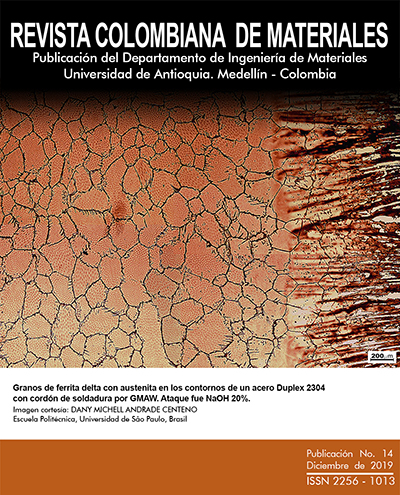Comparison of experimental and computational procedures for the evaluation of polymer matrix composites
DOI:
https://doi.org/10.17533/udea.rcm.340842Keywords:
computational modeling, composite materials, polymeric matrix, ceramic reinforcementAbstract
It has been found that composite materials offer desirables mechanical properties for the naval, structural, aerospace, automotive (among others) industries. The study of those materials has advanced significatively the fields of the physical and mechanical characterization using analytic formulations, and also in the field of the computational simulations particularly in the use of the Finite Elements Method (FEM). This method has been found useful in the prediction of the mechanical properties of the composites in cases in which the geometries or the load state is too complex for the use of analytical formulations or too expensive for its experimental evaluation. In this study the goal is to stablish a methodology for the definition of FEM models with predictive capabilities based in a limited series of inexpensive experimental tests and stablish the accuracy of those models. A series of laminates are produced by the specifications of a local firm in which the fiber orientation varies using the hand lay-up technique and those are characterized using traction, ignition and defects experimental methods. FEM models of the traction test for each laminated were defined using ANSYS ®and the results obtained were compared with the experimental results stablishing a mechanical response pattern under different configurations of fiber orientation, type and layer numbers. The results of the comparison between experimental and FEM approximations for the Mat (random oriented) laminates agree with an error lower than 6% while the error for the woven fabric in a 90° orientation reach the 34.2% which can be attributed to variations in the manufacturing process.
Downloads
References
A. Besednjak, Materiales Compuestos. Univ. Politèc. de Catalunya, 2009.
S. Mazumdar, Composites Manufacturing: Materials, Product, and Process Engineering, 1 edition. Boca Raton, Fla: CRC Press, 2001.
F. Aramide, P. Atanda, and O. Olorunniwo, “Mechanical properties of a polyester fibre glass composite,” International Journal of Composite Materials, vol. 2, no. 6, pp. 147–151, 2012.
M. Petrů and O. Novák, “FEM Analysis of Mechanical and Structural Properties of Long Fiber-Reinforced Composites,” Finite Element Method - Simulation, Numerical Analysis and Solution Techniques, Dec. 2017.
T. Sathishkumar, S. Satheeshkumar, and J. Naveen, “Glass fiber-reinforced polymer composites – a review,” Journal of Reinforced Plastics and Composites, vol. 33, no. 13, pp. 1258–1275, Jul. 2014.
N. K. Naik and V. K. Ganesh, “Prediction of on-axes elastic properties of plain weave fabric composites,” Composites Science and Technology, vol. 45, no. 2, pp. 135–152, Jan. 1992.
S. Oller and E. Oñate, “Advanced Models for Finite Element Analysis of Composite Materials,” in Wiley Encyclopedia of Composites, American Cancer Society, 2012, pp. 1–13.
A. Dixit and H. S. Mali, “Modeling techniques for predicting the mechanical properties of woven-fabric textile composites: a Review,” Mech Compos Mater, vol. 49, no. 1, pp. 1–20, Mar. 2013.
L. N. McCartney, “Analytical Methods of Predicting Performance of Composite Materials,” in Failure and Damage Analysis of Advanced Materials, H. Altenbach and T. Sadowski, Eds. Vienna: Springer, 2015, pp. 191–254.
K. Rohwer, S. Friedrichs, and C. Wehmeyer, “Analyzing Laminated Structures from Fibre-Reinforced Composite Material,” Technische Mechanik. Wissenschaftliche Zeitschrift für Grundlagen und Anwendungen der Technischen Mechanik, vol. 25, no. 1, pp. 59–79, 2005.
I. Kreja, “A literature review on computational models for laminated composite and sandwich panels,” Open Engineering, vol. 1, no. 1, pp. 59–80, 2011.
“Properties: E-Glass Fibre,” AZoM.com. [Online]. Available: https://www.azom.com/properties.aspx?ArticleID=764. [Accessed: 06-Nov-2019].
“Cristalan 1847.” [Online]. Available: http://www.andercol.com.co/inicio-construccion-e-infraestructura/energia/cristalan-1847. [Accessed: 06-Nov-2019].
D30 Committee, “Test Method for Tensile Properties of Polymer Matrix Composite Materials,” ASTM International.
D20 Committee, “Practice for Classifying Visual Defects in Glass-Reinforced Plastic Laminate Parts,” ASTM International.
D20 Committee, “Test Method for Ignition Loss of Cured Reinforced Resins,” ASTM International.
J. C. H. Affdl and J. L. Kardos, “The Halpin-Tsai equations: A review,” Polymer Engineering & Science, vol. 16, no. 5, pp. 344–352, 1976.
“Carbon Composites -2nd Edition.” [Online]. Available: https://www.elsevier.com/books/carbon-composites/chung/978-0- 12-804459-9. [Accessed: 06-Nov-2019].
S. Zhang, C. Caprani, and A. Heidarpour, “Influence of fibre orientation on pultruded GFRP material properties,” Composite Structures, vol. 204, pp. 368–377, Nov. 2018.
Downloads
Published
How to Cite
Issue
Section
License
Copyright (c) 2019 Revista Colombiana de Materiales

This work is licensed under a Creative Commons Attribution-NonCommercial-ShareAlike 4.0 International License.








